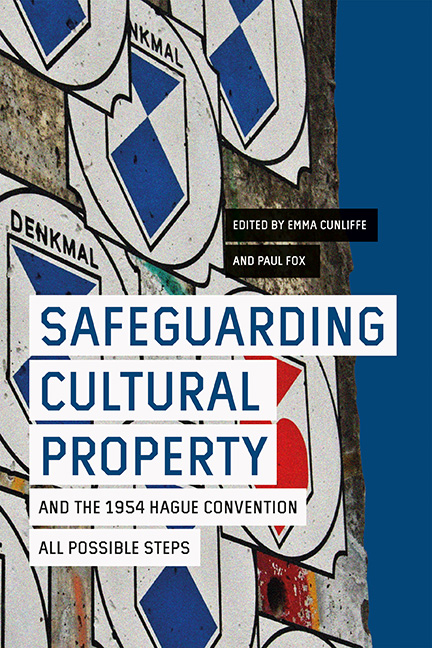Book contents
- Frontmatter
- Contents
- List of Illustrations
- List of Contributors
- Plate Section
- Acknowledgements
- List of Abbreviations
- Preface: The Blue Shield and the Protection of the World's Cultural Property – Preparing in Peace for Conflict
- Part I Safeguarding – Reassessing the Field
- Part II Historical Perspectives
- Part III Current Issues in Legal Implementation
- Part IV The Hague Convention in Practice Today: Tools and Approaches
- Appendix 1 The Hague Convention for the Protection of Cultural Property in the Event of Armed Conflict with Regulations for the Execution of the Convention 1954
- Appendix 2 Regulations for the Execution of the Convention for the Protection of Cultural Property in the Event of Armed Conflict
- Appendix 3 Resolutions of the 1954 Hague Conference
- Appendix 4 Second Protocol to the Hague Convention of 1954 for the Protection of Cultural Property in the Event of Armed Conflict 1999
- Appendix 5 Additional Protocols (1977) to the Geneva Conventions (1949) (Extracts)
- Index
- HERITAGE MATTERS
6 - The Role of Armed Non-State Actors in Safeguarding Cultural Heritage: Beyond Legal Obligations?
Published online by Cambridge University Press: 26 May 2022
- Frontmatter
- Contents
- List of Illustrations
- List of Contributors
- Plate Section
- Acknowledgements
- List of Abbreviations
- Preface: The Blue Shield and the Protection of the World's Cultural Property – Preparing in Peace for Conflict
- Part I Safeguarding – Reassessing the Field
- Part II Historical Perspectives
- Part III Current Issues in Legal Implementation
- Part IV The Hague Convention in Practice Today: Tools and Approaches
- Appendix 1 The Hague Convention for the Protection of Cultural Property in the Event of Armed Conflict with Regulations for the Execution of the Convention 1954
- Appendix 2 Regulations for the Execution of the Convention for the Protection of Cultural Property in the Event of Armed Conflict
- Appendix 3 Resolutions of the 1954 Hague Conference
- Appendix 4 Second Protocol to the Hague Convention of 1954 for the Protection of Cultural Property in the Event of Armed Conflict 1999
- Appendix 5 Additional Protocols (1977) to the Geneva Conventions (1949) (Extracts)
- Index
- HERITAGE MATTERS
Summary
Recalling the destruction of the Buddhas of Bamiyan at the hands of the Taliban in March 2001 in Afghanistan, UNESCO adopted a ‘Declaration concerning the Intentional Destruction of Cultural Heritage’ in 2003 (UNESCO 2003). Despite being a reaction to destruction at the hands of a de facto authority which was not recognised as a state entity, namely the Taliban regime, the 2003 UNESCO Declaration focuses on the obligations of states in preventing the intentional destruction of cultural heritage. The adoption of this Declaration did not halt iconoclasm. To the contrary, the emergence of new Islamist extremist groups, in particular the Islamic State group (IS), led to many further attacks on cultural heritage. These deliberate attacks have even been used for propaganda, with footage surfacing of members of IS toppling statues at the Mosul museum in Iraq, in 2015, or of members of Ansar Dine and Al-Qaeda in the Islamic Maghreb (‘AQIM’) destroying mausoleums in Timbuktu, in 2012.
The continued intentional destruction of cultural objects and sites by extremist groups has led to much criticism and condemnation at the global level. Both the United Nations (UN) Human Rights Council and the UN Security Council issued resolutions addressing the destruction of cultural heritage. For the first time since its creation, the UN Security Council dedicated an entire resolution solely to cultural heritage in 2017 (UNSCR 2017). In this Resolution, only states were commended for their efforts ‘to protect and safeguard cultural heritage in the context of armed conflicts’, whilst armed non-state actors (ANSAs) were only mentioned with regard to their involvement in ‘the destruction of cultural heritage and the trafficking in cultural property’ (UNSCR 2017, Preamble).
Despite the clear destructive intent of some ANSAs towards cultural heritage, the binary understanding according to which states are the sole protectors of cultural heritage against the actions of ANSAs does not reflect the reality. The spotlight placed on those ANSAs having adopted a destructive policy towards cultural heritage has overshadowed the efforts undertaken by other ANSAs to protect it from destruction or trafficking, whether at the hands of the government, other ANSAs, or the civilian population.
- Type
- Chapter
- Information
- Safeguarding Cultural Property and the 1954 Hague ConventionAll Possible Steps, pp. 113 - 124Publisher: Boydell & BrewerPrint publication year: 2022



